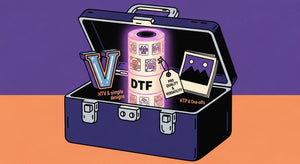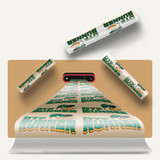Table of Contents
- What is Direct to Film Printing?
- How Does DTF Printing Work?
- What Are Advantages of DTF Heat Transfers?
- What Are Applications of DTF Heat Transfers?
- DTF Heat Transfers vs. Other Printing Methods
- Equipment Needed for DTF Printing
- How to Optimize DTF Printing
- Common Issues and Troubleshooting in DTF Printing
- The Environmental Impact of DTF Printing
- Future Trends in DTF Printing
- DTF Printing in the Global Market
- The Role of DTF Printing in E-Commerce
- Final Thoughts
DTF printing has taken the textile decorating world storms: functional, efficient, and a completely new method for applying a design onto fabrics. First, find out with this guide what DTF heat transfers are, how they work, and why they are the right choice for your printing.
What is Direct to Film Printing?
DTF printing is when the design is first printed on special film, which then undergoes heat and pressure to be transferred onto fabric. Unlike other methods of printing onto fabric, such as screen printing or DTG printing, DTF heat transfers do not require any pre-treatment of the fabric. In that respect, the entire process is much faster and more functional with regard to making detailed and colorful designs in a very broad range of materials.

How Does DTF Printing Work?
First is the digital printer with special DTF inks. So, this would be put in reverse onto a polyethylene terephthalate PET film. The design would then be coated with one layer of adhesive powder after it has been printed. This is an important powder since it binds the design onto the fabric during its heat transfer process. After that, this film is hardened through a heat press at a certain temperature and under a certain pressure to ensure that the design is stuck to the fabric.
What Are Advantages of DTF Heat Transfers?
DTF heat transfers have many advantages over the other methods of printing. First, they are versatile enough to be applied to several kinds of fabrics like cotton, polyester, blends, and even leather. Such flexibility makes DTF one of the best options in personalizing various garments and accessories. DTF printing produces durable, high-quality designs with bright colors and fine details. It's also more effective, as there is no need to spend time preparing set-up or pre-treating the fabrics, saving you in cost and time.
What Are Applications of DTF Heat Transfers?
The applications of DTF heat transfers are endless and wide-ranging. They work well for any type of custom apparel—and this is not limited to T-shirts, hoodies, or even hats. Among other uses of DTF printing are promotional items such as tote bags, aprons, and jackets. Indeed, the ability to print on non-traditional fabrics may open up possibilities for creation, which is enabled with the personalized design on shoes, gloves, and other complements. DTF heat transfers can be used with Custom DTF Products.
DTF Heat Transfers vs. Other Printing Methods
Compared to other printing methods, DTF heat transfers have many differences. For example, if you are into screen printing, then another screen will be required for each color used. Now, regarding DTF printing, it seems that full-color designs do not require a number of screens. All of this raises the process's complexity and costs. Although similar, direct-to-garment printing usually applies only to cotton-based fabrics and requires pre-treatment of the fabric. DTF heat transfers can, on the other hand, be used on most fabrics and do not require pre-treatment. Thus, they are more versatile and efficient.
Equipment Needed for DTF Printing
The basic equipment required for DTF printing are:
- A DTF printer
- DTF inks
- PET film
- Adhesive powder
- A heat press
The DTF printer is specially made to work with the specific inks and films involved in the process. DTF inks are specially formulated to return dynamic colors and strong adhesion to film. The medium used for printing the design onto is a PET film; an adhesive powder is applied to make the design stick on the T-shirt under heat. Finally, the design is cured onto the fabric using a heat press.
How to Optimize DTF Printing
Get the best from your DTF printing process. Follow these tips:
- Use High-Quality Inks and Films: Make sure to use good, high-quality DTF inks alongside the PET film to give way to brilliant colors with detailed designs.
- Maintain Equipment: Have a regular program of cleaning and good maintenance of the DTF printer and heat press so you wouldn't have any problems and the equipment would last longer.
- Test various settings: Conduct different heat press combinations in temperature, pressure, and time to find the correct outcome of sublimation. Trial runs will help lock in the best settings to use on your specific fabric and the design to be printed.
- Proper Storage: Keep your PET films and adhesive powders in a cool and dry place for optimal storage to maintain their efficacy.
Common Issues and Troubleshooting in DTF Printing
Much the same as any other kind of printing technique, DTF printing has some common issues. Here are a few troubleshooting tips:
- Poor Adhesion: If the design is not sticking to the fabric, make sure that you are using the correct temperature and pressure settings on your heat press.
- Ink Smudging or Blurring: This happens if you have a bad handle of the PET film after it has been printed. Allow the design to dry completely before applying the adhesive powder.
- Color Fading: If the product fades right after washing, we need to check the quality of your inks and whether the cure process has been properly executed.
The Environmental Impact of DTF Printing
While DTF printing offers a huge number of advantages we need to evaluate its activity for the environment. Inks and films for DTF are generally synthesized from synthetic raw materials that might increase plastic wastes in case they aren't disposed of properly. Not surprisingly, some manufacturers are slowly developing more eco-friendly DTF inks and recyclable PET films. In addition to this, the efficiency of DTF printing itself is also foreseen to reduce waste when compared to the traditional methods since it applies designs exactly without the excess material it holds.

Future Trends in DTF Printing
Several trends indicate that the future will be bright for DTF printing. Improvements in DTF printer technology will promote better print quality and speed, thus making the process highly efficient. Besides, the development of eco-friendlier DTF materials is likely to be the next in line, considering that the industry seems to be very interested in reducing its carbon footprint. Since demand for customized and personalized products remains at a phenomenal increase, DTF printing has an excellent position in regard to taking up this challenge.
DTF Printing in the Global Market
DTF printing has recently been fast gaining popularity worldwide. For a case in point, DTF technology in North America, Europe, and Asia is currently taking the textile printing industry by storm. Small and large manufacturing enterprises alike will soon understand why DTF heat transfers are so beneficial. In explaining this development, it can be pointed out that such a trend to embrace DTF heat transfer technology globally is mainly instigated by the increasing demand for customized apparel, promotional merchandise, and other fashion-like articles. Such a growth therefore inherently has the milestone of high-quality print yields, very fast and effective.
The Role of DTF Printing in E-Commerce
E-commerce has generally opened frontiers for businesses to expand and reach more customers. In this line of business, DTF printing plays a significant role by giving online retailers the ease of offering customized products to customers. In this sense, DTF heat transfers enable any company to quickly produce one-off designs or limited quantities of customized goods without facing any of the setup expenses typically related to printing techniques. What could be especially helpful for print-on-demand services is flexibility. Items are only produced in this scenario upon receiving an order, which lowers overall waste and inventory levels.
DTF heat transfers offer versatility and efficiency as a solution for printing onto fabric. High-quality images, durable, can be made on any fiber provided that one is fully equipped and applies proper techniques. Whether you are just starting with DTF printing or simply trying to refine your process, this guide provides an overview of DTF printing to get you started on customization. With the ever-changing state of technology, DTF printing is sure to gain popularity with small business owners and individual makers alike. Knowing the in-and-outs of the latest trends and best practices will give you the best vantage point for harnessing this innovative printing method.
Final Thoughts
This versatility and efficiency make DTF heat transfers a very obvious choice for any textile printer. From small custom jobs to large-scale production, DTFrunner provides flexibility and quality. You can always go with your design or for a quick result go to our ready press section. As you bring out what is possible with DTF heat transfers, be sure to keep far from the latest happenings and continue fine-tuning your process for the best results. For your designs gang sheet concept is a great way to scale up your business. I suggest you grab an outfit right now and decorate it with your own tastes!






